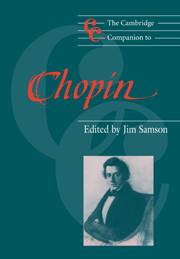Book contents
- Frontmatter
- Myth and reality: a biographical introduction
- PART 1 The growth of a style
- PART 2 Profiles of the music
- PART 3 Reception
- 9 Chopin in performance
- 10 Chopin reception in nineteenth-century Poland
- 11 Victorian attitudes to Chopin
- 12 Chopin's influence on the fin de siècle and beyond
- Appendix A historical survey of Chopin on disc
- Notes
- List of Chopin's work
- Bibliographical note
- Index
9 - Chopin in performance
from PART 3 - Reception
Published online by Cambridge University Press: 28 September 2011
- Frontmatter
- Myth and reality: a biographical introduction
- PART 1 The growth of a style
- PART 2 Profiles of the music
- PART 3 Reception
- 9 Chopin in performance
- 10 Chopin reception in nineteenth-century Poland
- 11 Victorian attitudes to Chopin
- 12 Chopin's influence on the fin de siècle and beyond
- Appendix A historical survey of Chopin on disc
- Notes
- List of Chopin's work
- Bibliographical note
- Index
Summary
It was just over a hundred and fifty years ago that Parisian audiences were hearing Chopin play his newly-composed piano works for the first time. His music was accepted very rapidly into the repertoire of the piano and by the end of the nineteenth century he was widely regarded as the piano composer par excellence. Since that time virtually every pianist has at some stage of his career included Chopin's pieces in recital programmes. This chapter considers the playing of a selection of noted Chopin exponents and examines various influences that have affected the style in which his music has been interpreted.
Of the century and a half of Chopin playing, we are fortunate in having sound recordings of pianists whose careers have covered over three-quarters of this period. Thus a relatively comprehensive study of changes in the style of Chopin playing is possible. However, sadly we do not possess discs of any Chopin pupils, the last of whom died as late as 1922; the earliest-born pianist to record his music, the Frenchman Francis Planté, was a mere ten-year-old when the composer died in 1849.
There are only two sources that can be consulted in investigating performances by pianists of the period closest to Chopin: firstly, the written accounts of those who heard them play and, secondly, critical editions prepared by performers, such as von Biilow, which reflect their ideas on how the music should be interpreted. This data, however, leaves a number of questions unanswered. Perhaps the most controversial aspect of all is that of tempo.
- Type
- Chapter
- Information
- The Cambridge Companion to Chopin , pp. 189 - 205Publisher: Cambridge University PressPrint publication year: 1992
- 3
- Cited by

